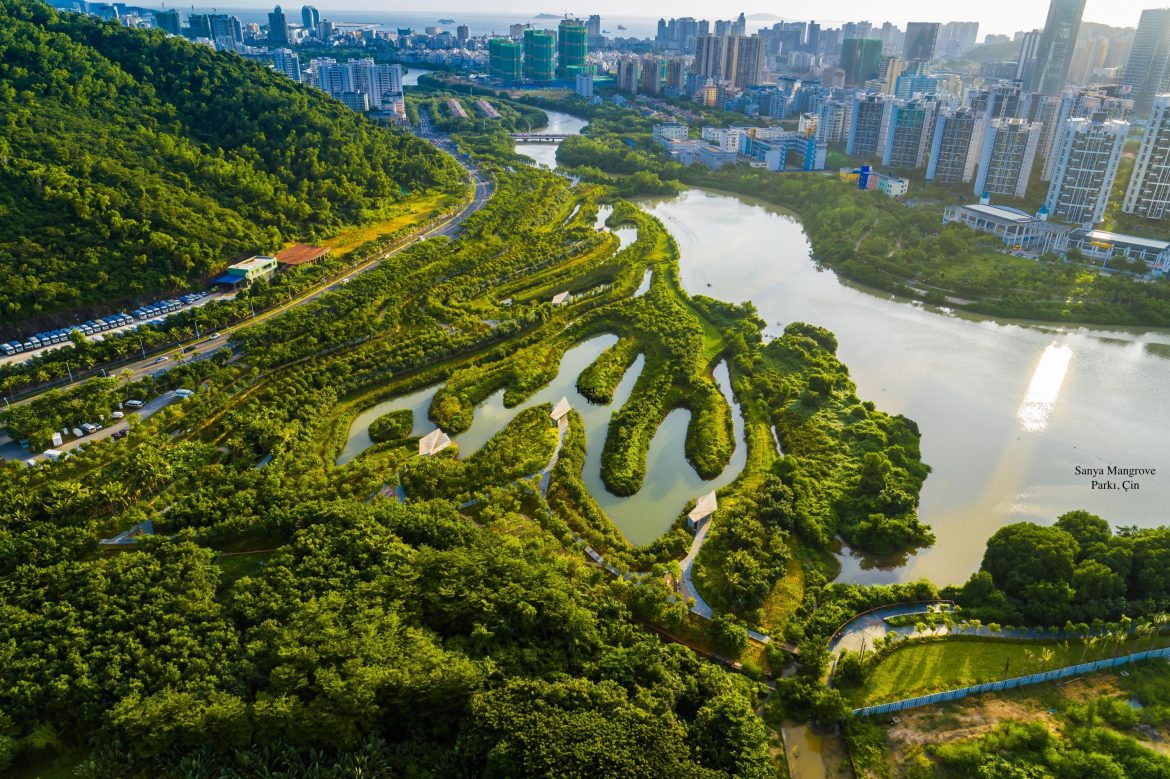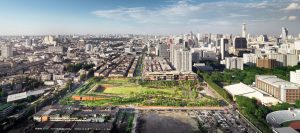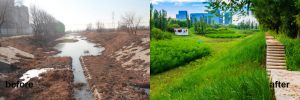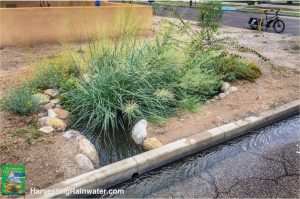
Adapting to the Changing Climate: Sponge Cities
Summer is coming, the weather is warming and some of us think about possible water shortages.
On the other hand, inconsistent rain patterns, extreme weather events, and warming oceans related to the climate crisis legitimize our concerns more and more every passing year. Thus, unexpected summer storms, warmer winter months, abrupt daily temperature changes and other variable climate events not only affect our daily lives, but have other consequences such as disrupting delicate agricultural application schedules, and shaping the future of all living beings and biodiversity in a much longer term and on a much broader geography. The impacts of climate instability can be much more visible in urban areas where population density is very high. Cities are dependent on large dams for water supply and can go through difficult times during drought, all the while, the same urban areas can receive hundreds of kilograms of rainwater per square meter on a couple of hot summer days. This may lead to a waste of invaluable amounts of rainwater, as well as flood events that further increase soil erosion and cause loss of lives and property. Last year’s unfortunate floods in Pakistan show this truth explicitly. However, this is not limited only to third-world countries such as Pakistan; flash floods, which hit Northern Europe, mainly Holland, Belgium, and Germany in the summer of 2021, made it clear that we’re all in the same boat. On a day in June, after a hot spell period of three days, when the highest temperatures since the beginning of the 20th century were recorded on three consecutive days, rain began. In just two days, more than 160 mm/m2 of rain fell, reservoirs were full, sewage systems flooded, rivers burst, and soon, cities and towns were under water.
Flash floods or regular control, there are many cities in the world where the administration needs to deal with a lot of water and has special methods for doing so.
At the core of ecological, holistic, or regenerative design methods, lies cooperation with nature, not fighting against it. This means manipulating natural forces and beings such as the sun, wind, soil, plants, and animals in order to meet our needs while deflecting the dangers and threats they may cause. Designing the water management system of a city intertwined with its core aspects, just like a wetland where excess water is absorbed like a “sponge” and released during dry periods, is becoming more and more relevant in recent years for preventing flood-related disasters. Even our country has become familiar with the concept of “sponge cities.”
The United Nations describe sponge cities as urban spaces where trees, ponds, and parks of green nature absorb the excess rainwater and prevent floods. In order to mitigate climate-related flash floods and problems caused by these floods, experts believe that cities and urban areas need to be re-designed or re-evaluated with this approach in mind. Nature-based designs, parks, gardens, ponds, green roofs, artificial wetlands, permeable surfaces and sidewalks (that enable rainwater filtering through) and similar techniques are used in sponge cities.
Rainwater harvesting or nature-based water management involves a three-step approach; slow, spread and sink. Whatever the scale, whether a small garden or an urban park with hundreds of acres of surface area, the same approach applies. Many projects around the world follow this approach and here are some.
Bangkok, Thailand

With 11 million residents, Bangkok, the capital city of Thailand lies on the wetlands of the Chao Praya River delta, which connects to the Gulf of Thailand. It is only 1.5 meters from the sea level, steadily sinking due to f increasing urbanisation (2 cm every year). After the floods in 2011, which killed hundreds of people, architects and urban planners started to work on feasible solutions. One of these solutions is a 45.000 m2 park constructed in the city centre, designed by the architect Kotchakorn Voraakhom and completed in 2017. The green space lies at the bottom of a hill, diverts surface flow to gardens and artificial wetlands, and then collects it in a water retention pond on the lowest level of the park. It also collects more than 600.000 liters of filtered rainwater in tanks buried under the park. These green spaces not only hold rainwater but also help with air pollution and stabilise high temperatures by regulating the heat island effect common in urban areas.
Beijing, China
 After the devastating floods in Beijing in 2012, the Chinese government started a project that aimed to create 16 sponge cities. Architect Kongjian Yu, who is working in the field, says “All cities treat water as if it’s an enemy” and claims sponge cities need to open more space for water. Yongxing Park, which was a concrete drainage channel before the project, is now a sponge park covered with a variety of trees and shrubs, interconnected with walking paths and playgrounds, where flood water is controlled, and rainwater is filtered.
After the devastating floods in Beijing in 2012, the Chinese government started a project that aimed to create 16 sponge cities. Architect Kongjian Yu, who is working in the field, says “All cities treat water as if it’s an enemy” and claims sponge cities need to open more space for water. Yongxing Park, which was a concrete drainage channel before the project, is now a sponge park covered with a variety of trees and shrubs, interconnected with walking paths and playgrounds, where flood water is controlled, and rainwater is filtered.
Copenhagen, Denmark
In 2011, Copenhagen witnessed an unusual event when almost one year’s worth of rainfall happened in just a few hours and most parts of the city were flooded with rainwater with a height of 1.5 metres. The economic value of the damage is thought to be about one billion euros. The disaster triggered the government’s administrative offices to react, and a big climate park was planned. It was a difficult task because the park was built in 1928 and the planners needed to protect the cultural heritage, while also preparing it for the future.

The 35.000 m2 park is located at the bottom of a hill and designed to capture large amounts of rainwater, such as a storm that can happen once in a hundred years. The area was constructed to retain rainwater as a temporary buffering storage until the rain slows down, and can hold up to 25 million litres of water. In order to achieve this, the concrete sports field was dug 3 meters deep so it can fill up with the first major rains. Then the rainwater overflows to the sunken rose gardens next to it and finally overflows to a pond. Just like the example in Thailand, the cisterns are placed underneath the park to store filtered rainwater that can be used to supply water to houses in the neighbourhood. The park is lined with a wall on all sides –without damaging the ancient trees– so that it can hold all the water up to the level of the wall when needed.
Tucson, Arizona, USA
Rainwater management and sponge city applications are not limited to large urban areas, city centres and systems of central green areas and parks. The town of Tucson is located in a typical arid/desert climate of Arizona, USA, where the residents are carrying out small-scale, local projects with their own resources. A community of mindful neighbours are diverting the run-off flowing over impermeable surfaces such as roads with dug out water retention basins, swales and similar earthworks nearby, thus saving millions of litres of rainwater every year, which would otherwise be wasted. Moreover, these water retention basins are filled with local plant varieties, fruit and nut trees that do not require extra irrigation, so they produce food as well as lowering the temperatures by regulating the heat island effect, all the while strengthening the social interaction of the neighbourhood.

People realised that even in an arid climate like Tucson, the total volume of rainfall (250 mm/m2/year) in the area is higher than the actual water consumption provided by the municipality; rainwater falls where water is used. In short, they saw that more water falls as rain than the residents’ water demand. So they decided to store the rainwater falling on their roofs instead of using municipal water coming from the Colorado River, many kilometres away, requiring high amounts of energy to be transported by pumps and pipes. This may seem like a small impact, but shows that it is possible to live a decent life by depending solely on rainwater even in an arid climate. Besides harvesting rainwater, they divert grey water to the plants in the landscape, where they only use natural local perennials, and utilise other water-saving techniques to achieve true water sustainability and demonstrate that it is possible. In time, the local government realised the importance and the impact of these interventions and began supporting the citizens who wish to harvest rainwater in their neighbourhoods.
İzmir, Türkiye
İzmir Metropolitan Municipality is the first local government in Türkiye to define itself as a sponge city. The sponge city project began last year and includes rain gardens, water retention ponds, permeable landscaping materials and rainwater management systems in basins.
‘‘Rainwater management aims to catch the water, store it and filter it by using green infrastructure techniques based on natural processes. This helps reduce urban floods, the urban heat island effect, and enhances the environment and biological diversity. It purifies contaminants in the runoff water and helps maintain a cleaner environment. Harvested or stored rainwater is used for irrigation or in houses.’’

‘‘[Sponge city approach] is based on managing the rain falling on urban areas by using green infrastructure techniques. The main idea is to catch, store and infiltrate the rainwater as close as possible to where it falls. Thus, runoff water flowing on the streets and roads, as well as the pressure on existing storm water infrastructure is reduced, and floods are prevented. Green infrastructure techniques also help enhance the natural environment, increase biodiversity and reduce heat island effects.’’
As part of its sponge city project, İzmir Metropolitan Municipality distributes 5.000 rainwater tanks and provides technical support for building 10.000 rain gardens for the residents of İzmir.
The studies show that nature-based urban water management is 50% cheaper and 28% more efficient than man-made systems. It is obvious that preferring low-tech, low carbon footprint and low-cost systems, in other words, learning millions of years of evolutionary processes, environments and approaches, is our best choice during times when impacts of the climate crisis are deepening and extreme weather events are creating serious socio-economic instability. Trusting nature is the best thing we can do!
REFERENCES
- 1. https://edition.cnn.com/2023/03/26/world/flooding-cities-water-design-climate-intl/index.html
- 2. https://www.euronews.com/green/2022/10/22/china-s-sponge-cities-are-a-revolutionary-rethink-to-prevent-flooding
- 3. https://climatechampions.unfccc.int/what-are-sponge-cities-and-how-can-they-prevent-floods/
- 4. https://www.economist.com/europe/2021/07/16/devastating-floods-in-germany-warn-europe-of-the-dangers-of-warming
- 5. https://sungerkent.izmir.bel.tr/
- 6. Lancaster, Brad, Rainwater Harvesting for Drylands and Beyond, 2019, Rainsource Press
